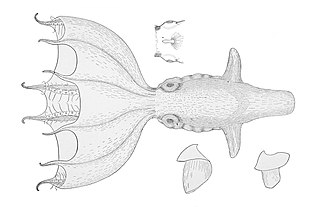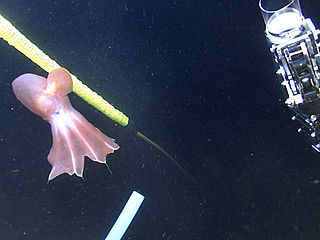
Cirroteuthidae is a family of pelagic cirrate octopuses comprising at least three species in two genera.

Grimpoteuthis is a genus of pelagic cirrate (finned) octopods known as the dumbo octopuses. The name "dumbo" originates from their resemblance to the title character of Disney's 1941 film Dumbo, having two prominent ear-like fins which extend from the mantle above each eye. There are 17 species recognized in the genus. Prey include crustaceans, bivalves, worms and copepods. The average life span of various Grimpoteuthis species is 3–5 years.
Luteuthis dentatus, also known as Lu's jellyhead, is a medium-sized species of cirrate octopus found in the southwestern Pacific, originally described by Steve O'Shea.

Umbrella octopuses are a group of pelagic octopuses. Umbrella octopuses are characterized by a web of skin between the arms, causing them to somewhat resemble an opened umbrella when the arms are spread.

Stauroteuthis is a genus of deepwater cirrate octopus, a cephalopod mollusk. This is the only genus in the family Stauroteuthidae, and only three species have been described in this genus.

Teuthology is the study of cephalopods. Cephalopods are members of the class Cephalopoda in the Phylum Mollusca. Some common examples of cephalopods are octopus, squid, and cuttlefish. Teuthology is a large area of study that covers cephalopod life cycles, reproduction, evolution, anatomy and taxonomy.

Cirrina or Cirrata is a suborder and one of the two main divisions of octopuses. Cirrate octopuses have a small, internal shell and two fins on their head, while their sister suborder Incirrina has neither. The fins of cirrate octopods are associated with a unique cartilage-like shell in a shell sac. In cross-section, the fins have distinct proximal and distal regions, both of which are covered by a thin surface sheath of muscle.

Stauroteuthis syrtensis, also known as the glowing sucker octopus or bioluminescent octopus, is a species of small pelagic octopus found at great depths in the north Atlantic Ocean. It is one of a very small number of octopuses to exhibit bioluminescence.

Cirroteuthis muelleri, also known as the big-finned jellyhead, was the first cirrate octopus species to be scientifically described. It is closely related to the genus Cirrothauma within the family Cirroteuthidae. At present the genus contains a single recognized species restricted to the Arctic Ocean and northern basins of the Atlantic and Pacific, but other species may be present in the southern hemisphere.
Cryptoteuthis brevibracchiata, the short-arm flapjack octopod, is a deepwater species of octopod. It is the only species in the monotypic genus Cryptoteuthis one of the cirrate octopuses of the family Grimpoteuthidae, the umbrella octopuses. It is known from a single specimen which was collected in the northeastern Atlantic Ocean. It has characteristics which are shared with two other genera, Opisthoteuthis and Grimpoteuthis, but is sufficiently distinctive from either of these to warrant the erection of a new genus.
Luteuthis is a small genus of cirrate octopuses currently placed in the family Grimpoteuthidae. There are two species classified in this genus one from waters west of New Zealand and the other from the South China Sea.
Opisthoteuthis calypso or calypso flapjack octopus is a species of genus Opisthoteuthis, which are known as the cirrate octopuses. Octopuses in this genus are known as the flapjack octopuses and can be found in a variety of oceans across the world.

Opisthoteuthis agassizii is a lesser-known, deep-sea octopus first described in 1883 by Addison E. Verrill.
Opisthoteuthis borealis is a lesser-known species of octopus found near Greenland and Iceland, especially in the Davis Strait. The species was described from 9 specimens, and is one of the most recent Opisthoteuthis species described. Not much is known about it besides its anatomy and habitat.
Opisthoteuthis bruuni is a species of finned cirrate octopus found along the western coast of South America. Their tissue is almost jelly-like, and they have short, round bodies.
Opisthoteuthis massyae is an octopus living in the eastern Atlantic Ocean.
Opisthoteuthis persephone is a cirrate octopus living south of Australia. In particular, it lives in waters off Tasmania, Victoria, New South Wales, and South Australia. The octopus has been found 270–540 m (885.8–1,771.7 ft) deep. It lives near and directly above the seafloor. S. Stillman Berry was the first to scientifically describe this species after capturing eight specimens while aboard the F.I.S. Endeavour in the early 1910s. In describing O. persephone, Berry called it an "exceedingly interesting octopod".
Opisthoteuthis philipii is an octopus of the Indian Ocean. It lives off the coast of Kerala, India. Known specimens were found between 275–365 m (902–1,198 ft) deep in the Arabian Sea near Alappuzha.
Grimpoteuthis greeni is a dumbo octopus found in deep waters off southern Australia. The species was initially described from three specimens, with a further three specimens identified since then.
Stauroteuthis kengrahami is a species of small pelagic cirrate octopus. It is currently only known from off eastern Australia.









